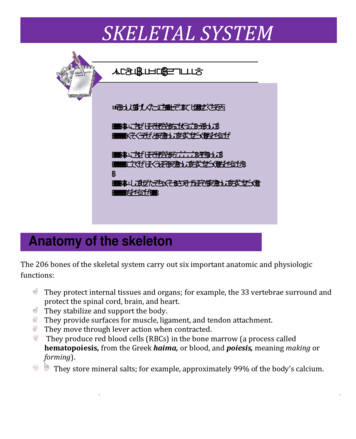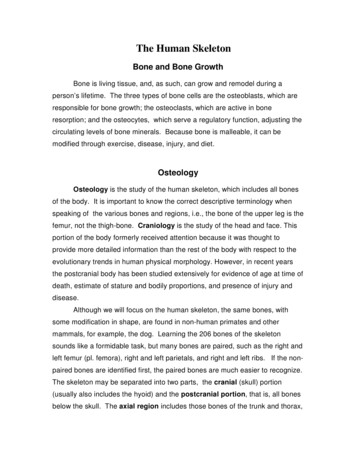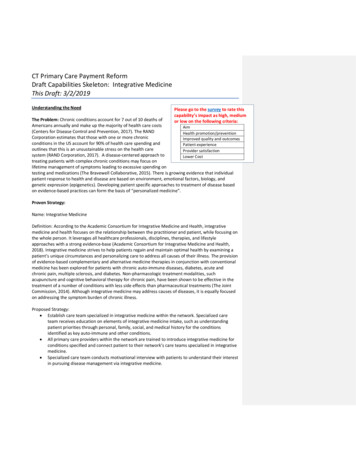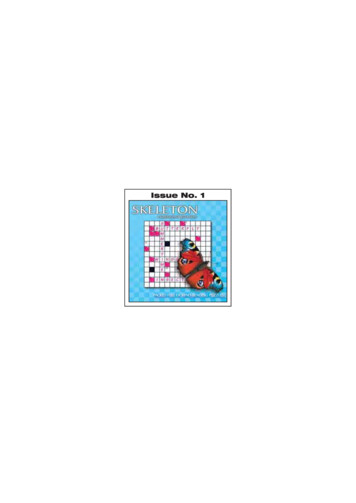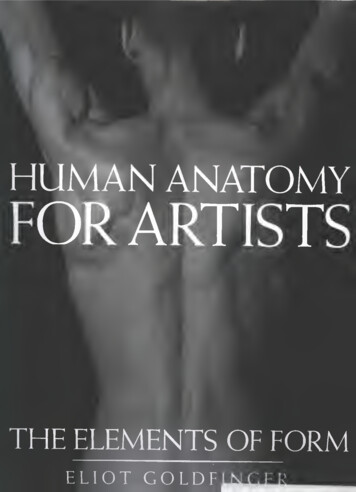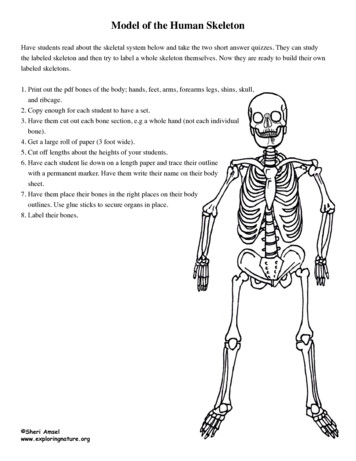
Transcription
Model of the Human SkeletonHave students read about the skeletal system below and take the two short answer quizzes. They can studythe labeled skeleton and then try to label a whole skeleton themselves. Now they are ready to build their ownlabeled skeletons.1. Print out the pdf bones of the body; hands, feet, arms, forearms legs, shins, skull,and ribcage.2. Copy enough for each student to have a set.3. Have them cut out each bone section, e.g a whole hand (not each individualbone).4. Get a large roll of paper (3 foot wide).5. Cut off lengths about the heights of your students.6. Have each student lie down on a length paper and trace their outlinewith a permanent marker. Have them write their name on their bodysheet.7. Have them place their bones in the right places on their bodyoutlines. Use glue sticks to secure organs in place.8. Label their bones. Sheri Amselwww.exploringnature.org
The Skeletal System - The Bones and What They DoThe Skeletal System: The skeleton forms the frame for the body and makes up about on fifth of the body’sweight. It is made up of 206 bones. It also includes cartilage, joints, and ligaments. Besides for forming ourbody frame, the skeleton has several other jobs. It is the anchor and support for all our muscles and even ourorgans. It protects our vital organs like the brain, spinal cord, heart and lungs. It allows us to move with musclesattached by tendons, using the bones as levers. It is a place for our body to store fat and minerals, like calcium.It is where the body makes most of its new blood cells. Bones come in many shapes and sizes. The long boneshave a long shaft and two bigger ends. These include the bones of the arms and legs. The largest bone in thebody, the femur, is a long bone. It is 2 feet long and hollow, to make it lighter. It is very strong to support thebody’s weight. The short bones are cube-shaped and include the wrist – the carpals, and the bones of the ankle– the, tarsals. The flat bones are thin, curved and flattened like the sternum and skull. Lastly, there are irregularbones such as the vertebra and pelvis. Each section of the skeleton has a job. Below see all the parts of theskeleton and how they work together to make the body a strong, moving machine.The Skull: The skull surrounds and protects the brain and the organs of hearing and balance. The facial bonesform the structure of the face, hold the eyes, and the organs for taste and smell and anchor the teeth. They havethe openings for air and food. The whole skull anchors muscles that hold the head up, allow us to chew, andform facial expressions.Arms and Hands: Each upper limb includes the humerus (arm), the radius and ulna (forearm) and the bones ofthe hand: 8 carpals (wrist), 5 metacarpals (palm) and 14 phalanges (fingers and thumb). The arm and forearmbend at the elbow in a hinge joint, which is not as flexible as the shoulder joint, but is much more stable. Thehand with its many joints is made to be flexible and agile. It can grasp and lift a heavy suitcase or careful pickup a pin. The upper limb is made to do both and everything in between.The Pelvis: is formed by 2 hip bones attach to the sacrum of the backbone. On the outside of each side is a deepsocket, called the acetabulum, where the head the leg bones (the femur) sits. The pelvis supports and protectsinternal organs, attaches the lower limb to the body and with the lower limb supports the weight of the wholeupper body. The hip joint is very important for leg movement and is supported by strong muscles and ligaments.Though it is a ball and socket joint like the shoulder, it is more stable and less moveable than that joint.Legs and Feet: The lower limb includes the femur (thigh), tibia (shinbone) and fibula (leg), and bones of thefoot: 7 tarsals (ankle), 5 metatarsals (foot) and 14 phalanges (toes). The kneecap (patella) sits in front of theknee joint, inside a muscle tendon. The femur is the largest bone in the body and makes up about one fourth ofa person’s height. It forms a ball and socket joint at the hip, with the pelvis, and a hinge joint at the knee, withthe tibia. The knee, a hinge joint, has less flexibility than the hip but is more stable, because the knee carries thebulk of the body’s weight. It is often injured. The entire weight of the body sits on the foot. The foot acts as alever to move the body forward when we walk or run.
The Skeletal System - The Bones and What They DoShort Answer QuizThe skeleton forms the frame for the body and makes up about one fifth of the body’s weight. It is made up of(#) bones. It also includes cartilage, joints, and ligaments. Besides for forming our body frame, theskeleton has several other jobs. It is the anchor and support for all ourand even our organs. It protects our vital organs like the brain, spinal cord, heart and lungs. It allows us to movewith muscles attached by , using the bones as levers. It is a placefor our body to store fat and minerals, like . It is where the bodymakes most of its new cells. Bones come in many shapes and sizes.The long bones have a long shaft and two bigger ends. These include the bones of the arms and legs. The largestbone in the body, the , is a long bone. It is 2 feet long and hollow, to make itlighter. It is very strong to support the body’s weight. The short bones are cube-shaped and include the bones ofthe wrist – the carpals, and athe bones of the ankle – the . The flat bones arethin, curved and flattened like the and skull. Lastly, there are irregular bonessuch as the vertebra and pelvis. Each section of the skeleton has a job. They work together to make the body astrong, moving machine.Choose from these vocabulary words (except for the number of ns Sheri Amselwww.exploringnature.org
The Bones of Skeletal System - Short Answer QuizThe skull surrounds and protects the and the organs of hearing and balance. Thefacial bones form the structure of the face, hold the eyes, and the organs for taste and smell and anchor the. They have the openings for air and food. The whole skull anchors musclesthat hold the head up, allow us to chew, and form facial expressions.Each upper limb includes the humerus (arm), the radius and (forearm) and thebones of the hand: 8 carpals (wrist), 5 metacarpals (palm) and 14 phalanges (fingers and thumb). The arm andforearm bend at the elbow in a joint, which is not as flexible as the shoulder joint,but is much more stable. The hand with its many joints is made to be flexible and agile. It can grasp and lift aheavy suitcase or careful pick up a pin. The upper limb is made to do both and everything in between.The pelvis is formed by 2 hip bones attach to the of the backbone.On the outside of each side is a deep socket, called the , wherethe head the leg bones (the femur) sits. The pelvis supports and protects internal organs, attaches the lowerlimb to the body and with the lower limb supports the weight of the whole upper body. The hip joint is veryimportant for leg movement and is supported by strong muscles and. Though it is a ball and socket joint like the shoulder, it is more stable and less moveable than that joint.The lower limb includes the femur (thigh), tibia (shinbone) and fibula (leg), and bones of the foot: 7 tarsals(ankle), 5 (foot) and 14 phalanges (toes). The kneecap( ) sits in front of the knee joint, inside a muscle tendon. The femuris the largest bone in the body and makes up about one fourth of a person’s height. It forms a ball and socketjoint at the hip, with the pelvis, and a hinge joint at the knee, with the tibia. The knee, a hinge joint, has lessflexibility than the hip but is more stable, because the knee carries the bulk of the body’s weight. It is ofteninjured. The entire weight of the body sits on the foot. The foot acts as a lever to move the body forward whenwe walk or run. Choose from these vocabulary words: acetabulum, brain, hinge, ligaments, metatarsals,patella, sacrum, teeth, ulna
Model of the Human Skeleton Have students read about the skeletal system below and take the two short answer quizzes. They can study the labeled skeleton and then try to label a whole skeleton themselves. Now they are ready to build their own labeled skeletons. 1. Print out the pdf bones of the body; hands, feet, arms, forearms legs, shins, skull,

